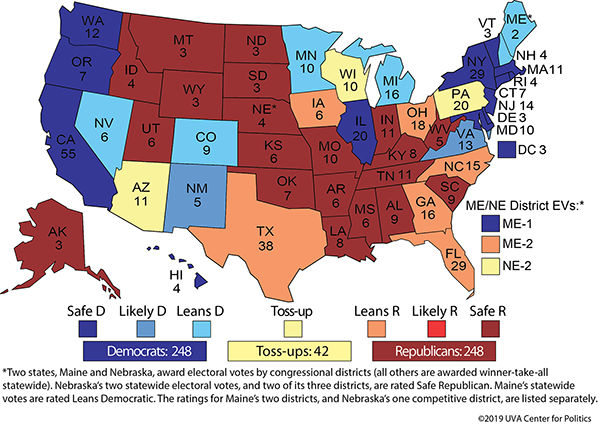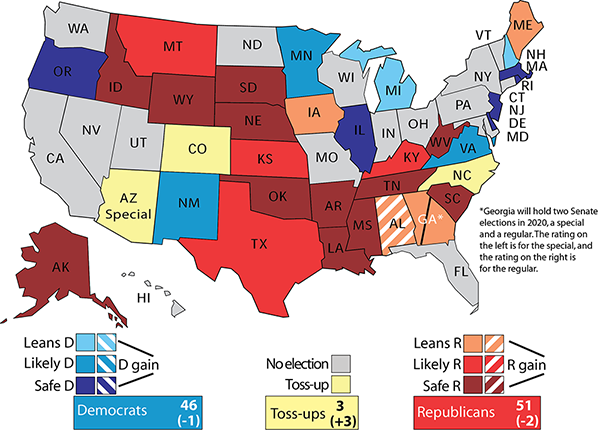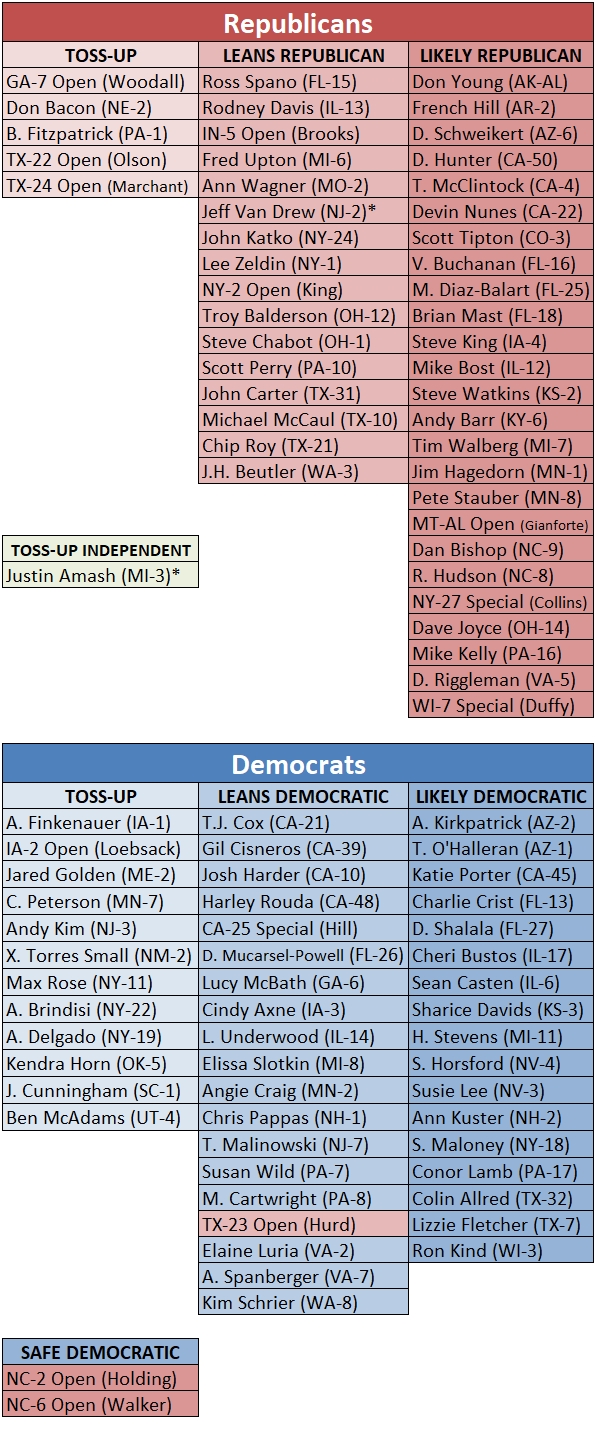2019: The Year of Stability
A Commentary By Kyle Kondik
Big events of the year, including impeachment, don’t materially change the odds in races for president, Congress.
KEY POINTS FROM THIS ARTICLE
— Impeachment is an unusual occurrence marked by usual partisanship. It is hard to argue that it has dramatically altered perceptions of the president.
— Overall, our outlook for the races for president and for Congress are pretty similar to what they were at the start of the year.
Impeachment, and a year in review
The House of Representatives made history Wednesday, impeaching a president for just the third time. It made for an occasion that was both momentous and monotonous. Momentous in that Donald J. Trump appears likely to be the first impeached president who will nonetheless appear on general election ballots after that happened, creating a truly unprecedented American political situation, and monotonous in that a predictable, almost entirely party-line vote sets up a Senate trial where the result (acquittal) seems preordained.
In other words, the specific circumstances of impeachment and what led to it are remarkable, but the reaction by the nation’s political actors is routine.
This is, ultimately, the Trump presidency in a nutshell. As we head into the fourth year of his presidency, the year where voters are poised to cast the verdict on his first term, stability is the watchword. The most important overall number in determining Trump’s odds for next year is his approval rating (the individual candidate head to heads matter later, but it’s still early to obsess over them). Based on the RealClearPolitics and FiveThirtyEight polling averages, Trump’s approval has been consistently in the low-to-mid 40s for essentially the entirety of Trump’s presidency. That is bad, though not fatal.
Impeachment has not markedly changed the president’s approval rating one way or the other; the most recent surveys, actually, have been slightly better for him than usual, but are still within the aforementioned range we’re accustomed to. Public opinion on impeachment itself is divided and largely stable, although some recent surveys have shown a slight improvement in the president’s position.
Just to illustrate the stability, we thought we’d use our last issue of the year to look back on our initial assessments for president, Senate, and House, and see how they’ve changed over the course of this off-year.
President
Initial Electoral College assessment: Feb. 28, 2019
With an approval rating in the low-to-mid 40s — and, perhaps more importantly, a disapproval rating consistently over 50% — it would be easy to say that President Trump is an underdog for reelection. The president won only narrowly in 2016 and did so while losing the national popular vote, making his national coalition precarious. He has done little to appeal to people who did not vote for him, and a Democrat who can consolidate the votes of Trump disapprovers should be able to oust him unless the president can improve his approval numbers in a way he has demonstrably failed to do in the first half of his term.At the same time, the president’s base-first strategy could again deliver him the White House, thanks in large part to his strength in the nation’s one remaining true swing region, the Midwest. He’s an incumbent, and incumbents are historically harder to defeat (although it may be that incumbency means less up and down the ticket in an era defined by party polarization).We could’ve written the exact same thing today and not had to change a single word.
Our initial ratings had 248 electoral votes at least leaning to the Republican nominee (Trump, almost certainly), 244 electoral votes at least leaning to the Democratic nominee, and 46 Toss-ups. Since then, we’ve made only one significant change, pushing Hillary Clinton’s most narrow 2016 victory, New Hampshire, from Toss-up to Leans Democratic, leaving a 248-248 split with just 42 electoral votes’ worth of Toss-ups (Arizona, Pennsylvania, Wisconsin, and Nebraska’s Second Congressional District).
The 2020 race still looks like a 50-50 proposition to us.
As for the Democratic nomination race, it is still very much in flux, although polling leader Joe Biden has proven to be durable despite his problems. We looked at Biden’s standing and the Democratic primary race in detail a couple of weeks ago.
If anything significant has changed, it may be that the threat of an election-year recession — which would seriously hamper Trump’s reelection chances, at least based on history — appears to have abated. The U.S. economy is steaming ahead with low unemployment, and modest wage growth is balanced by low inflation. Even if one grants that the benefits from economic growth are often unevenly felt, this is a positive backdrop for Trump. A normal president who avoids unnecessary disputes might well be cruising to reelection. However, almost no one would call Trump normal on this score. Yet his eccentricities may not blot out the helpful effects of a robust economy, and Democrats will only make their disadvantage worse by ignoring this reality or conducting a divisive, scarring nomination contest (or choosing a weak nominee).
Map 1: Crystal Ball Electoral College ratings
The Senate
Initial ratings: Dec. 13, 2018
Overall, in order to win the Senate, Democrats probably will need to win Arizona and Colorado as well as at least a couple of the Leans Republican states: Georgia, Iowa, Maine, or North Carolina. That these crucial states begin with Republicans as small favorites points to a larger overall assessment: the GOP starts this cycle favored to hold the Senate. However, there is a plausible path for Democrats, particularly if a Democrat wins the presidency and provides some down-ballot coattails.One striking thing about the Senate picture is that, of the races we think are the most competitive, there is not a single open seat among them. We rate 10 Senate races as either Toss-ups or leaning one way or the other, and all are slated to feature an incumbent running for reelection; that includes two appointed senators, Martha McSally (R-AZ) as well as Kelly Loeffler (R-GA), the latter of whom will take office early next year. On Wednesday, Sen. Susan Collins (R-ME) confirmed that she is running for reelection.
Retirements can dramatically shift the odds in a given race, but the lack of them in the top Senate races has kept the overall battle for the chamber in relative stasis.
The likeliest seat to flip remains Alabama, where Sen. Doug Jones (D-AL) is an underdog in a red state, while most of the other truly competitive races are Republican-held. The looming resignation of Sen. Johnny Isakson (R-GA) does give the Democrats an additional target that they did not possess at the start of the year, although neither seat in Georgia is a top-tier one, in our judgment.
Since our initial assessment, we did move North Carolina to the ranks of the Toss-ups, although Democratic odds are likely better in their other two Toss-up targets, Arizona and Colorado. Sen. Thom Tillis (R-NC) has gotten some good news over the past several weeks: his one-time primary challenger, businessman Garland Tucker (R), left the race, and Rep. Mark Walker (R, NC-6) opted to retire in the face of redistricting instead of enter the primary, which means Tillis can turn his attention to the general election now. The true vulnerability of Republicans in the Leans Republican column, namely Collins and Joni Ernst (R-IA), remains something of a question mark, although each very well could be pushed hard next year. Collins, in particular, seems to face a no-win situation on impeachment: A vote to convict will further nationalize her and imperil her longstanding crossover appeal (after her vote to confirm Brett Kavanaugh for a Supreme Court seat already nationalized her to a great degree last year), while a vote to acquit will soften her with Republicans. Without defeating at least one of Collins or Ernst, the Democratic path to a majority is likely blocked.
Our best guess at this point would be for something like a net Democratic gain of a seat, short of the three net seats Democrats need to forge a 50-50 tie. So we still favor the Republicans overall in the battle for the Senate, but the Democrats have enough targets to win control.
Map 2: Crystal Ball Senate ratings
The House
Initial ratings: Jan. 17, 2019
Even if President Donald Trump is renominated and reelected to a second term in the White House, it is not at all clear from history that his reelection would provide sufficient coattails to net the minimum needed gain of 18 Republican House seats. Indeed, the last five reelected presidents saw their parties fall short of that net total in their election years, and the House hasn’t switched from one party to the other and then back again in consecutive elections since 1952-1954… If Trump (or another Republican) does not win the presidency, it’s almost impossible to imagine the Republicans simultaneously losing the White House but gaining the House majority.Right now, we don’t see either side as clearly favored to win the White House, meaning that we’re looking at the race for the presidency as something of a Toss-up to start. And if winning the White House is a necessary but not sufficient requirement for Republicans to win the House — which we basically think it is — then the GOP’s odds of winning the House are, by definition, less than 50%, because holding the presidency alone probably is not enough for them to win the House.While there has been a considerable amount of churn in the House over the past year, this overall assessment also still stands. The Republicans have a path to a House majority, but the Democrats are bolstered by history: Party changes in the House usually occur in midterms, not presidential elections. Democrats, on balance, also have been helped by several developments over the past year. Retirements have hit Republicans harder than Democrats, creating more offensive opportunities for the majority party, and a court-ordered redistricting in North Carolina should easily net the Democrats a couple of extra seats.
Still, Republicans should bolster their ranks thanks to Rep. Jeff Van Drew’s (NJ-2) apparent party switch from Democratic to Republican, and the impeachment vote may allow Republicans to more easily nationalize Democratic House incumbents in districts that Trump carried. Following Van Drew’s imminent switch to the Republicans, and the creation of those two new Clinton-won seats in North Carolina that Democrats will carry, there are now 35 House members who hold districts won by the other party’s presidential candidate: 30 Democrats in Trump-won districts and five Republicans in Clinton-won seats (the full list is available on our House ratings page). There is a single independent, impeachment-backing Rep. Justin Amash (I, MI-3), who now sits in a Toss-up, Trump-won district.
The Republican path to winning the House largely goes through those 30 districts. While we don’t list any single Democratic House incumbent as a clear underdog in his or her race, the Republicans are going to beat some of these Trump-district incumbents. Impeachment may make that job easier for the GOP.
Overall, the House math is as follows. We currently list 225 House seats at least leaning to the Democrats, 192 at least leaning Republican, and 18 Toss-ups. Splitting the Toss-ups nine to nine would give the GOP a net seat of one; they need to net 18 seats to win the House. So we still see the Democrats as favorites in the House. However, there are enough Republican targets among the Trump-won seats held by Democrats, and among the marginal Clinton-won seats, where a parliamentary-style election in which incumbents don’t have much of an advantage and Trump is reelected provides a possible template for a GOP comeback in the House.
Table 1: Crystal Ball House ratings
Note: *Represents members who have changed parties. Rep. Jeff Van Drew (NJ-2) is poised to switch from Democratic to Republican, and Rep. Justin Amash (I, MI-3) switched from Republican to independent. Red districts listed in the Democratic column indicate the Democrats are favored to win those districts; blue districts listed in the Republican column indicate the Republicans are favored to win those districts.
Conclusion
This is all a long way of saying that despite all of the big political events of the past year, the overall political picture for November 2020 has not changed all that much. The presidential race remains in flux, and the two parties — Republicans in the Senate, Democrats in the House — retain various advantages as they seek to maintain their respective congressional majorities.
2019 was a lot of things, but game-changing — from a political standpoint — it was not.
Kyle Kondik is a Political Analyst at the Center for Politics at the University of Virginia and the Managing Editor of Sabato's Crystal Ball.
See Other Political Commentary by Kyle Kondik.
See Other Political Commentary.
This article is reprinted from Sabato's Crystal Ball.
Views expressed in this column are those of the author, not those of Rasmussen Reports. Comments about this content should be directed to the author or syndicate.
Rasmussen Reports is a media company specializing in the collection, publication and distribution of public opinion information.
We conduct public opinion polls on a variety of topics to inform our audience on events in the news and other topics of interest. To ensure editorial control and independence, we pay for the polls ourselves and generate revenue through the sale of subscriptions, sponsorships, and advertising. Nightly polling on politics, business and lifestyle topics provides the content to update the Rasmussen Reports web site many times each day. If it's in the news, it's in our polls. Additionally, the data drives a daily update newsletter and various media outlets across the country.
Some information, including the Rasmussen Reports daily Presidential Tracking Poll and commentaries are available for free to the general public. Subscriptions are available for $4.95 a month or 34.95 a year that provide subscribers with exclusive access to more than 20 stories per week on upcoming elections, consumer confidence, and issues that affect us all. For those who are really into the numbers, Platinum Members can review demographic crosstabs and a full history of our data.
To learn more about our methodology, click here.



